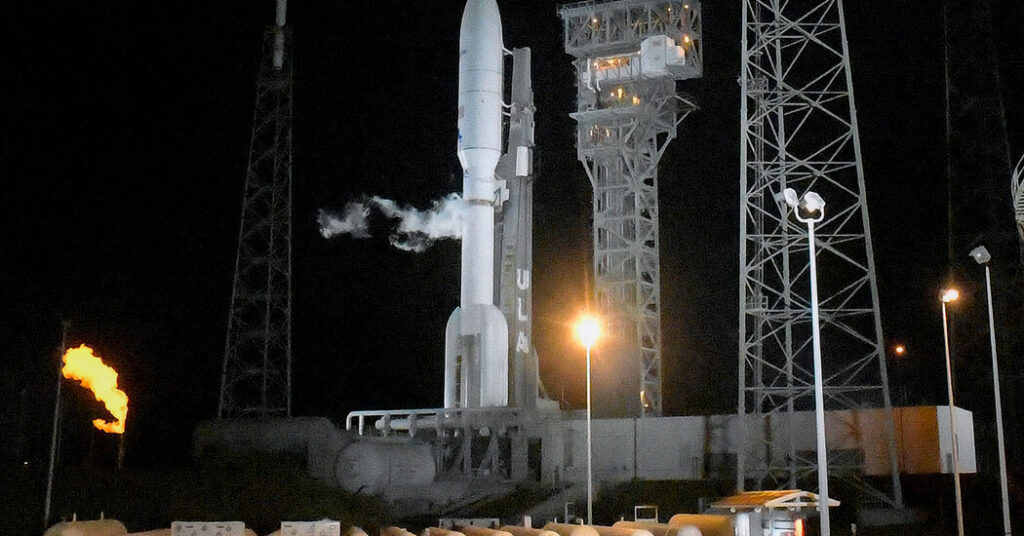The competition for space supremacy between billionaires Jeff Bezos and Elon Musk is set to expand into a new domain: satellite internet.
Amazon, founded by Mr. Bezos three decades ago as a simple online bookstore, has become a massive retail giant. It now owns the James Bond franchise, sells tech products like Echo smart speakers, and is a leading player in cloud computing.
So, it’s not surprising that Amazon is initiating the launch of the first batches of Project Kuiper satellites, aiming to offer a new means of staying connected in today’s digital age. Currently, the high-speed internet satellite market is led by Elon Musk’s SpaceX, which provides a similar service called Starlink. With thousands of satellites already active and more being launched almost weekly, Starlink has millions of customers worldwide.
The initial attempt to send these satellites into space on April 9 was delayed due to poor weather. However, the company is set to try again this Monday.
When is the launch and how can I watch it?
The first batch of 27 Project Kuiper satellites is planned for launch on Monday between 7 and 9 p.m. Eastern Time from Cape Canaveral Space Force Station in Florida. They will be launched on an Atlas V rocket, developed by United Launch Alliance, a partnership between Boeing and Lockheed Martin.
U.L.A. will provide live coverage starting at 6:35 p.m., and the company currently forecasts a 70 percent chance of favorable weather for the launch.
The satellites will be placed in a circular orbit at an altitude of 280 miles above Earth. Their propulsion system will then increase their altitude to 393 miles over time.
What is Project Kuiper?
Project Kuiper aims to create a network of internet satellites that will deliver high-speed data connections to nearly every location on Earth. Achieving this will take thousands of satellites, with Amazon aiming to operate over 3,200 in total in the coming years.
The initiative will compete with SpaceX’s Starlink, which was initially targeted toward residential users.
While Kuiper is targeting that consumer market, particularly in hard-to-reach areas, it will also integrate with Amazon Web Services, the company’s cloud computing service preferred by large corporations and governments worldwide. This integration may appeal to businesses requiring satellite imagery or weather data, as they often need to transfer and analyze large data volumes.
Ground stations will connect the Kuiper satellites to the web services infrastructure, allowing companies to communicate with their remote operations. For instance, Amazon has indicated energy firms might use Kuiper to oversee and manage remote wind farms or offshore drilling sites.
In October 2023, Amazon launched two prototype Kuiper satellites to test the technology, with positive outcomes reported. These prototypes were not intended for continuous use and were deorbited after seven months, burning up upon re-entry. The company later revised all designs for systems and subsystems on the satellites based on these tests.
“Launching two satellites is very different from sending 3,000 into space,” noted Rajeev Badyal, an Amazon executive overseeing Kuiper, in a promotional video preceding the launch.
When will Amazon start offering internet service from space?
In a statement to the Federal Communications Commission in 2020, Amazon mentioned that internet service would commence once its first 578 satellites were in orbit. The company has expressed expectations of connecting customers to the internet sometime later this year.
Although a fully operational constellation requires thousands of satellites, the company can begin offering service in select areas with far fewer satellites in orbit, planning to expand to wider global service later.
The F.C.C. approved the constellation with the condition that at least half of the satellites must be deployed by July 30, 2026. Analysts believe Amazon might receive an extension if it shows significant progress by then.
The successful launch of satellites depends on timely rocket launches, which could be hindered if there aren’t enough rockets available. Additionally, Amazon is tasked with constructing hundreds of ground stations to facilitate communication with users.


